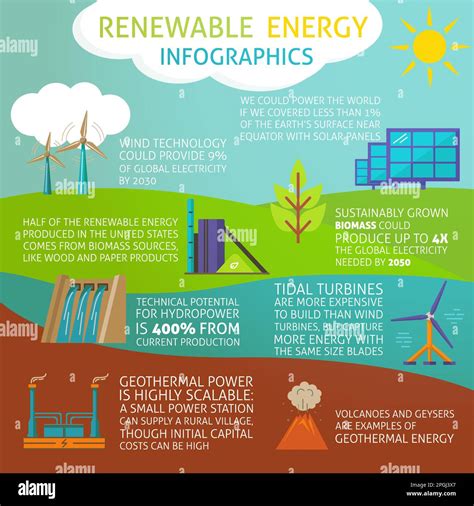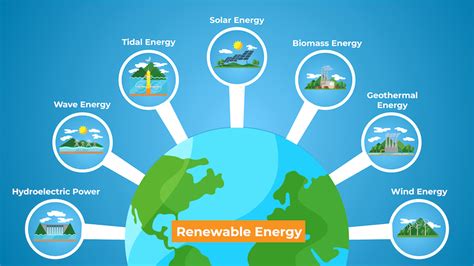As the world continues to grapple with the challenges of climate change, environmental degradation, and energy sustainability, the importance of green energy sources has become increasingly evident. Green energy, also known as renewable energy, is derived from natural resources that can be replenished over time, offering a cleaner and more sustainable alternative to fossil fuels. In this article, we will delve into five green energy sources that are revolutionizing the way we generate, consume, and think about energy. From solar and wind power to hydro, geothermal, and biomass energy, these sources are not only reducing our reliance on fossil fuels but also creating new opportunities for economic growth, job creation, and environmental stewardship.
Key Points
- Solar energy is becoming increasingly cost-competitive with fossil fuels, with the cost of solar panels decreasing by over 70% in the last decade.
- Wind power is one of the fastest-growing sources of renewable energy, with global installed capacity reaching over 740 gigawatts (GW) in 2022.
- Hydro energy is the largest source of renewable energy, accounting for over 15% of global electricity generation, with a total installed capacity of over 1,200 GW.
- Geothermal energy has the potential to provide both heating and cooling, with over 13 GW of installed capacity worldwide, and a growth rate of 4-5% per annum.
- Biomass energy can be generated from a wide range of organic materials, including agricultural waste, forestry residues, and wastewater, with over 130 GW of installed capacity globally.
Solar Energy: Harnessing the Power of the Sun

Solar energy is one of the most promising green energy sources, with the potential to meet a significant portion of our energy needs. The cost of solar panels has decreased dramatically over the years, making it more accessible and affordable for individuals, businesses, and governments to invest in solar energy. According to the International Energy Agency (IEA), solar energy could become the largest source of electricity globally by 2050, with solar panels generating over 27% of the world’s electricity. The advantages of solar energy are numerous, including zero greenhouse gas emissions, low maintenance costs, and energy independence.
Technological Advancements in Solar Energy
Advances in technology have played a crucial role in improving the efficiency and affordability of solar energy. The development of bifacial solar panels, which can generate electricity from both the front and back sides of the panel, has increased energy output by up to 25%. Additionally, the use of solar trackers, which adjust the angle of the solar panels to maximize energy production, has become more widespread. These innovations have not only improved the efficiency of solar energy but also reduced the cost of production, making it more competitive with fossil fuels.
| Solar Energy Capacity | Installed Capacity (GW) |
|---|---|
| Global | 720 |
| China | 205 |
| United States | 125 |
| Europe | 120 |

Wind Energy: Tapping into the Power of the Wind

Wind energy is another green energy source that has gained significant traction in recent years. The global wind market has experienced rapid growth, with over 740 GW of installed capacity, and is expected to reach 1,000 GW by 2025. Wind energy offers several benefits, including low operating costs, reduced greenhouse gas emissions, and job creation. The development of larger, more efficient turbines has improved the economics of wind energy, making it more competitive with fossil fuels.
Offshore Wind Energy: A New Frontier
Offshore wind energy has emerged as a new frontier in the wind industry, with the potential to generate vast amounts of clean energy. The advantages of offshore wind energy include stronger, more consistent winds, and reduced visual impact. However, the development of offshore wind farms requires significant investment in infrastructure, including transmission lines, substations, and maintenance vessels. Despite these challenges, offshore wind energy is becoming increasingly cost-competitive, with the cost of offshore wind energy decreasing by over 50% in the last five years.
Hydro Energy: The Largest Source of Renewable Energy
Hydro energy is the largest source of renewable energy, accounting for over 15% of global electricity generation. Hydroelectric power plants harness the energy of moving water to generate electricity, offering a reliable and constant source of power. The advantages of hydro energy include high energy conversion efficiency, low operating costs, and reduced greenhouse gas emissions. However, the development of new hydroelectric projects is often limited by geographical constraints, environmental concerns, and social impacts.
Pumped Storage Hydro: A Solution for Energy Storage
Pumped storage hydro (PSH) is a type of hydro energy that involves pumping water from a lower reservoir to an upper reservoir during off-peak hours, using excess energy from other power sources. During peak hours, the water is released back to the lower reservoir, generating electricity. PSH offers a solution for energy storage, allowing for the stabilization of the grid and the integration of intermittent renewable energy sources. With over 150 GW of installed capacity worldwide, PSH is becoming an essential component of the global energy mix.
Geothermal Energy: Tapping into the Earth’s Heat
Geothermal energy is a green energy source that harnesses the heat from the Earth’s core to generate electricity. The advantages of geothermal energy include high energy conversion efficiency, low operating costs, and reduced greenhouse gas emissions. Geothermal energy can be used for both electricity generation and heating, offering a reliable and constant source of power. However, the development of geothermal projects is often limited by geographical constraints, with the best resources located in regions with significant volcanic activity.
Enhanced Geothermal Systems: A New Technology
Enhanced geothermal systems (EGS) are a new technology that involves creating artificial reservoirs to tap into the Earth’s heat. EGS offers the potential to unlock geothermal resources in areas where natural reservoirs are not available, increasing the global potential for geothermal energy. The development of EGS requires significant investment in research and development, but it could play a crucial role in the transition to a low-carbon economy.
Biomass Energy: Generating Energy from Organic Materials

Biomass energy is a green energy source that generates energy from organic materials, including agricultural waste, forestry residues, and wastewater. The advantages of biomass energy include reduced greenhouse gas emissions, energy independence, and job creation. Biomass energy can be used for electricity generation, heat production, and transportation fuels, offering a versatile and reliable source of power. However, the development of biomass projects is often limited by feedstock availability, cost, and environmental concerns.
Advanced Biomass Conversion Technologies: A New Generation
Advanced biomass conversion technologies, such as gasification and pyrolysis, offer a new generation of biomass energy production. These technologies involve the conversion of biomass into synthesis gas or bio-oil, which can be used to generate electricity, produce biofuels, or create chemicals. The advantages of advanced biomass conversion technologies include high energy conversion efficiency, reduced emissions, and improved feedstock flexibility.
What is the current status of green energy sources in the global energy mix?
+Green energy sources currently account for over 26% of global electricity generation, with solar and wind energy being the fastest-growing sources. However, fossil fuels still dominate the global energy mix, accounting for over 60% of energy production.
How can we accelerate the transition to a low-carbon economy?
+To accelerate the transition to a low-carbon economy, we need to create an enabling environment that encourages investment in green energy sources, improves energy efficiency, and promotes sustainable land use. This can be achieved through a combination of policy measures, technological innovations, and behavioral changes.
What are the main challenges facing the development of green energy sources?
+The main challenges facing the development of green energy sources include high upfront costs, intermittency, and infrastructure constraints. Additionally, the development of green energy projects often requires significant investment in research and development, as well as policy support and regulatory frameworks.



